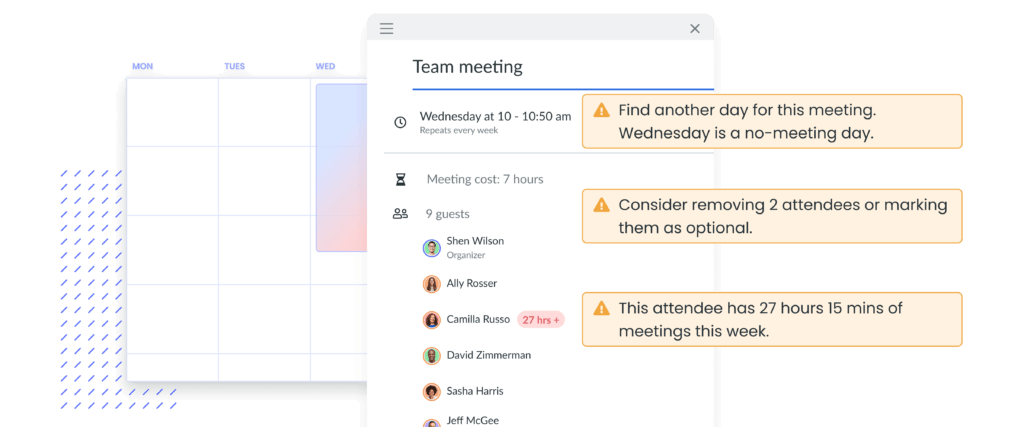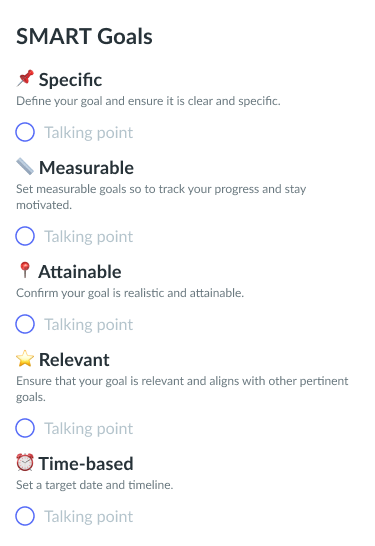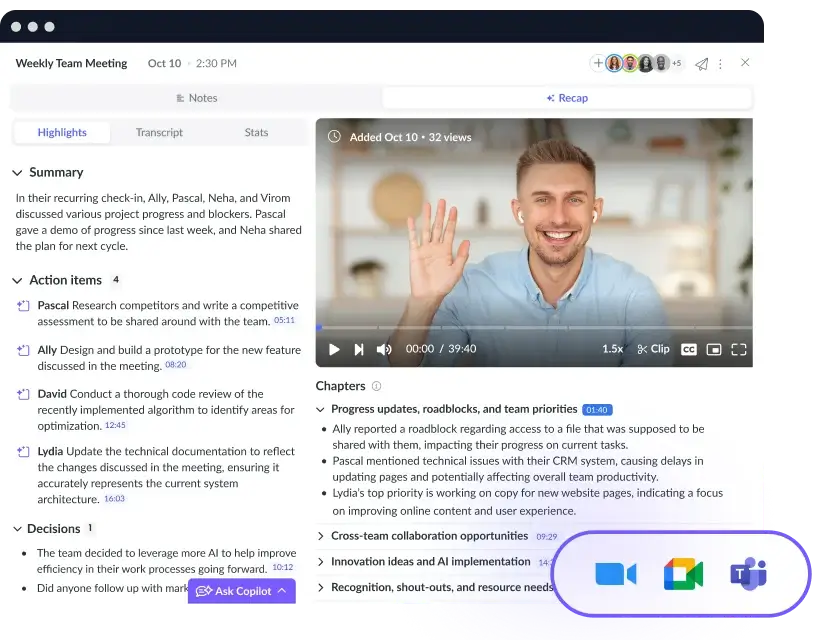How to Improve Time Management: 10+ Proven Tips
If you’re unsure how to improve time management at work, consider implementing these 11 tips to get started.
People who often use the phrase “so much to do and so little time” likely need some help improving their time management skills.
Because even though there often is a lot to do, when you know how to manage your workday effectively, there actually is a lot of time to get it done. If you’re ready to work smarter—but not necessarily harder or for longer—and learn how to improve time management skills, keep reading!
- The importance of time management
- The role of Fellow in time management
- 11 time management best practices
The importance of time management
Knowing how to improve time management at work is crucial regardless of your role. Effective time management allows you to accomplish more in a shorter time, giving you the flexibility to focus on other action items, be more productive, and lower your stress.
When done well, time management can also lead to benefits like:
- Improved work-life balance: Knowing how to manage your time at work effectively means you can spend time outside of work on things that matter most without stressing about your to-do list.
- Increased productivity: You’re able to get more done with the time you have.
- Reduced stress: Effective time management means you can better plan your time and meet tight deadlines.
- Effective delegation: Managers who know how to manage their time also learn how to delegate specific tasks to their team so they have the time and ability to focus on higher-level tasks that can lead to greater success within the organization.
- Improved resource management: When you know how to improve time management skills, you can put more resources and effort toward accomplishing your short-term and long-term goals.
The role of Fellow in time management
Teams that use Fellow are able to run efficient meetings, come to a decision, and get back to work. Fellow helps improve time management by streamlining meetings with collaborative meeting agendas that ensure meetings start and end on time. In Fellow, once the meeting starts you’ll see a countdown clock under the title of the note. This will reflect the amount of time remaining in the meeting and will countdown as the meeting progresses to help you end your meetings on time. Fellow’s meeting automations also allow the meeting organizer to automate part of the meeting workflow including sending reminders, cancelling if there is no agenda, and send out recaps afterwards.
Plus, we all know that meetings with too many people can cause meetings to go overtime. Fellow’s Meeting Guidelines feature set helps you ensure only the most essential attendees are in your meetings. If a meeting has more than 7 attendees, Fellow will send the meeting organizer a prompt to remove additional attendees, or mark them as optional. Fellow also helps you reclaim time in your day with no meeting days. The best and easiest way to implement a no meeting day is by using a tool that has the functionality already baked in. As part of the Meeting Guidelines feature set, Fellow enables company leaders to set a no meeting day for their organization, so that any time someone tries to schedule a meeting on that day, they will be automatically prompted to find another time.
Furthermore, making room for deep work and execution is important if you want to increase team productivity. Fellow’s Meeting Guidelines feature set helps eliminate back to back meetings by making them speedy. With the help of this feature, meeting organizers are automatically prompted to shorten the meetings they’re creating by 5 – 10 minutes, so attendees can get a break in between meetings. Less meeting fatigue, and more time for deep work! And finally, Fellow helps eliminate the last-minute meeting problem with the Meeting Guidelines feature set for Google Calendar users. With this feature, when a meeting is being scheduled to be within the next four hours, the meeting organizer is prompted to give attendees more notice, and schedule it later in the day.

Save time with Fellow
Improve your time management by getting your team working together to transform meetings across your organization with meeting automations and best practices integrated into every Google Calendar event.
11 time management best practices
Ready to start understanding how to improve time management skills? Consider implementing these 11 best practices to get started.
- Prioritize your tasks
- Delegate tasks
- Use a time management tool
- Set SMART goals
- Establish realistic deadlines
- Learn how to say “no”
- Tackle your most difficult task first
- Avoid multitasking
- Limit distractions
- Find your productive hours
- Create a plan
1Prioritize your tasks
Most people start off improving time management by creating a comprehensive to-do list. While this list is helpful, instead, begin time management by thinking about what needs to get done first, and then prioritize your tasks by the most important.
Take the time to create a list of tasks based on priority and cross them off as you go. You can also list these tasks based on how long you estimate they’ll take, so not only do you feel accomplished when you cross them off, but you’re also using your time in a smarter way.
2Delegate tasks
Knowing how to delegate tasks is also an important part of time management. Delegating work to your direct reports and colleagues based on their skills, abilities, and expertise can free up time for you to work on other challenging or time-consuming tasks, brainstorm strategies, and more.
When you decide to delegate, always set clear expectations for your direct report, provide feedback, and show appreciation once the task has been completed.
3Use a time management tool
It’s also a good idea to use a time management tool. For instance, taking advantage of a tool like Fellow can help teams stay organized and on track. Plus, its tracking progress is simple thanks to Fellow’s Objectives feature. There, you can link your objectives within a team meeting to review progress, resolve challenges, and keep all objectives and key results (OKRs) on track.
Additionally, Fellow offers teams a better way to track action items, which you can prioritize and manage to save time. In just a few clicks, you can assign, visualize, and prioritize all your meeting to-dos in one place and sync them with Jira, Asana, and Zapier.
4Set SMART goals
Managers and their teams should also establish SMART goals for improving time management, which should be easily defined and acted upon. SMART goals are:
- Specific
- What are you looking to accomplish?
- Measurable
- What numbers should be reached to know if you’re making progress?
- Achievable
- What do you need to achieve the goal?
- Relevant
- What does the business gain when this goal is achieved?
- Time bound
- Can you reach this goal in a set amount of time?
When setting SMART goals for you and your team, remember to go one letter at a time, track the progress as much as you can, and ask your team for feedback along the way.
5Establish realistic deadlines
Knowing how to improve time management at work also means knowing how to set realistic deadlines for every task–and stick to them. And while it’s fine to have “shoot for the stars” deadlines and expectations sometimes, improving time management isn’t an ideal time to do so.
Instead, set a deadline before the actual due date so that you and your team can be ready for any challenges or hurdles that come up along the way.
6Learn how to say “no”
Next, learn how to say “no”, and get comfortable doing so.
Those who excel at time management know that you only have so many hours in the day–and your time is precious. So, say “no” to tasks that aren’t your priority so you can focus on more important and impactful tasks. You never want to bite off more than you can chew.
While it’s easy to fall into saying “yes” to everything and taking on as many responsibilities as possible to make a good impression, you’ll slowly start to feel overwhelmed, and it’ll only slow you down in the long run. Determine how much work is ideal and then practice confidently saying “no” and decline workloads that will go beyond this time limit or boundary. Remember, you don’t need to feel bad saying “no”; simply explain to the other person that you don’t have the time and don’t want the quality of the result to suffer.
“Saying no—politely but firmly—is an art form, and if you can master it, you’ll feel much more in control of your time. Very often, it’s not even a case of saying no but setting expectations for when you can do something—for example, by saying something like ‘I can’t do this until next week.'”
— Bernard Marr, Forbes
7Tackle your most difficult task first
Another great way to improve time management is to prioritize your tasks and consider addressing the most difficult ones first so you can cross those items off before moving on to easier ones that may need less time or energy.
Also known as the Eat the Frog technique, this concept centers around finishing your most dreaded task first. This is especially helpful for procrastinators who often do their smallest tasks first and put off the bigger ones. Every procrastinator knows that as you do your work, those bigger tasks loom larger and larger until there’s no avoiding them.
So, when improving your time management skills, only move on to other, easier tasks once you’ve eaten the frog.
8Avoid multitasking
It’s also in your best interest to avoid multitasking. Even though switching back and forth between tasks might cost only a few seconds per switch, it can quickly add up if you multitask frequently. Multitasking also puts you at risk of making smaller mistakes more often and can negatively affect your working memory and ability to focus on important tasks, which means things will start to fall through the cracks.
“Multitasking is the enemy of productivity because you can end up not doing anything properly. Give one task at a time your full attention, and finish that before moving on to the next item.”
9Limit distractions
It’s easy to get distracted by incoming emails, direct messages, text messages, or the urge to scroll social media. But more often than not, getting distracted by these factors can get in the way of improving your time management skills.
Avoid these common distractions by turning your phone on Do Not Disturb or setting it out of reach. You can also choose a Do Not Disturb setting on various business instant messaging software, like Slack. Another tip is to set a specific timeframe during the day for when you check your email or other messages so you’re not constantly distracted by incoming messages in your inbox as you try to get various tasks completed.
10Find your productive hours
Everyone has their most productive hours, and you should determine yours!
For some, their most productive hours are in the morning before they break for lunch. For others, it’s in the evening when most have left the office for the commute home. Whatever the case may be, lean into when you find yourself most productive and use this time wisely.
“Productive people don’t fill every hour of their day—they know when they work best, and they make sure they get the important stuff done during those hours. Follow their lead and block out your most productive hours (be they in the morning, in the quiet of the evening, or whatever) for the most important tasks.”
11Create a plan
Last but not least, create a plan for how you’ll approach your list of tasks and action items. For instance, you could go about the day by calendar blocking; this time management technique allows you to break your workday into sections depending on what’s ahead of you. You’ll give everything on your task list a specific time slot in your calendar, and once it’s done, you move on to the next!
Time is of the essence
Since you only have so many hours in the day, learn to use every hour wisely by improving your time management skills. Remember, improving these skills is an ongoing process that requires self-discipline, commitment, and dedication. By implementing these strategies consistently, you and your team can achieve your goals more effectively and get more done throughout the day—especially when armed with a time management tool like Fellow that takes everything you’ve learned one step further!













